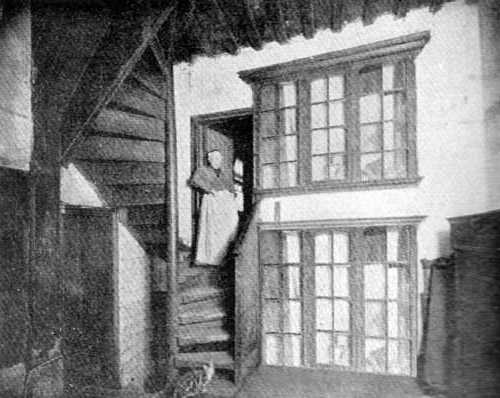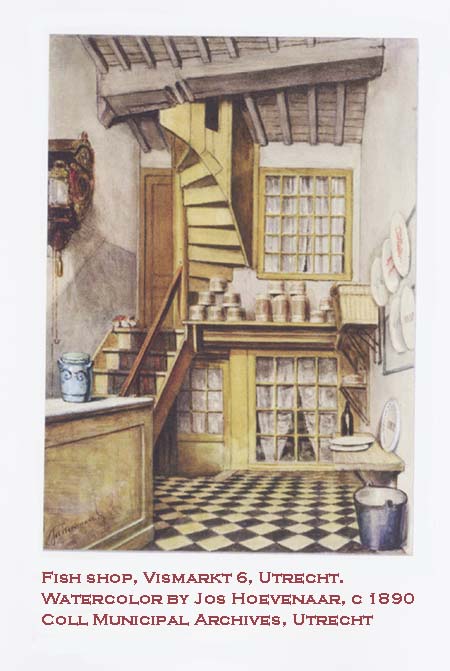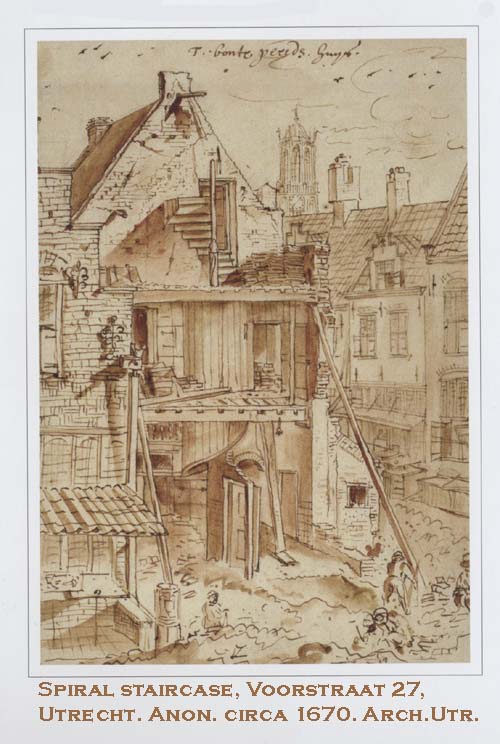

 Function
of the room: Room on street level, sometimes the full width of the
house and often at quite some height (2.5 - 4 meters). It was used as
a reception and showroom for the specific profession of the
inhabitant. In Vermeer's case he displayed some paintings ; the room
was just over half the width of the house.
Function
of the room: Room on street level, sometimes the full width of the
house and often at quite some height (2.5 - 4 meters). It was used as
a reception and showroom for the specific profession of the
inhabitant. In Vermeer's case he displayed some paintings ; the room
was just over half the width of the house.
In the Thins/Vermeer house, the right-hand part has been occupied to accomodate the 'room above the basement' (B) at a height of about 1 meter. This room could be reached by a stairway going five steps up in the middle of the forehouse. Below it is the basement (E) At the backwall of the forehouse there were interior windows which allowed light into the split-level kitchens just behind which could be reached via the street or via the lower cooking kitchen (D). The celler (E) could be reached via the cooking kitchen (D). For a recent study of rooms and their use, see Fock, 2001.
Inventory: "A small fruit painting, een freutschilderytje ; A small seascape, een zeetje ; A small landscape, een landschapje ; A painting by [Carel] Fabritius, een stuckie schildery door fabritius
A cabinet of jointry work, een schrijnwercktkasie ; A large painting of Mars and Apollo in a bad black frame, een groot stuk schilderij van mars ende apollo in een slechte swarte lijst ; Two paintings somewhat smaller, twee schilderijen wat kleijnder ; Four more paintings with bad frames, nog vier schilderijtgens met slechte lijsten ; A mirror with an ebony frame, een spiegel met een ebbe lijst ; A wooden footbench, een houte voutbanckie; Four bad green chairs, vier slechte groene stoelen ; Two bad tapestry-covered cushions, twee slechte tapijte sitkussens."
See the original documents from the Delft Archives. Goods owned by Catharina Bolnes, page 1, page 2, page 3, page 4, page 5, page 6, page 7. Goods jointly owned by Catharina Bolnes and Maria Thins, page 1, page 2, page 3, page 4, page 5, page 6.

Photo manipulated with Photoshop, showing the spiral staircase to the left in the Forehouse. In the Vermeer house the hallway was at ground floor level according to Zantkuijl, not five steps up as shown in this photo. The sets of windows allow light into the Inner kitchen (above) and Cooking kitchen (below). Original photo see below.
 In
1640 an English traveler going about in the Republic, noted these words in his
'Travels of Peter Mundy in Europe and Asia 1608-1667':
In
1640 an English traveler going about in the Republic, noted these words in his
'Travels of Peter Mundy in Europe and Asia 1608-1667':
"As For the art off Painting and the affection off the people to Pictures, I thincke none other goe beeyond them, there having bin in this Country Many excellent men in thatt Faculty, some att presentt, as Rimbrandtt, etts [etcetera], All in generall striving to adorne ther houses, especially the outer or street roome, with costly pieces, Butchers and bakers not much inferiour in their shoppes, which are Fairely set forth, yea many times blacksmithes, Coblers etts., will have some picture or other by the Forge and in their stalle. Such is the genrall Notion, enclination and delight that these Countrie Native[s] have to Painting."
Note : This room and these objects were part of the Vermeer-inventory as listed by the assistant of Delft notary public J. van Veen on February 29, 1676, in the Thins/Vermeer home located on Oude Langendijk on the corner of Molenpoort. The painter Johannes Vermeer had died there at the end of December 1675. His widow Catherina and their eleven children still lived there with her mother Maria Thins.
The transcription of the 1676 inventory, now in the Delft archives, is based upon its first full publication by A.J.J.M. van Peer, "Drie collecties...", Oud Holland, 1957, pp. 98-103. My additions and explanations are added within square brackets [__]. Dutch terms have been checked against the world's largest language dictionary, the Dictionary of the Dutch Language (Woordenboek der Nederlandsche Taal , or WNT), which was begun by De Vries en Te Winkel in 1882.
C. Willemijn Fock, Titus M. Eliëns, Eloy F. Koldeweij, Jet Pijzel Dommisse, Het Nederlandse interieur in beeld 1600 - 1900, Waanders, Zwolle, 2001.

The photo above was Photoshop altered by Allan Kuiper to resemble the situation in the Vermeer-Thins house.
The original photo of a house at the Kraaiengang alley in Amsterdam, demolished in 1909, is to the right.
This page forms part of a large encyclopedic site on Vermeer and Delft. Research by Drs. Kees Kaldenbach (email). A full presentation is on view at johannesvermeer.info.
Launched December, 2002; Last update March 1, 2017.
Back to the Welcome page: click Welcome.

A spiral staircase led from the Voorhuis (Forehouse) to the upstairs floor and the attic. The drawing above shows a similar spiral staircase in a house located on on Voorstraat 27 in Utrecht.
.